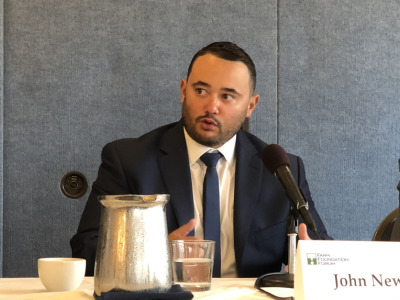Democrats on the House and Senate Agriculture committees see the farm safety net as broader than the major commodity programs and want to make sure that the next farm bill addresses needs of smaller-scale producers, committee aides say.
“It is very important to the Democrats in the House and on committee to support a farm safety net that is making sure to support small farmers and family farmers,” Emily Pliscott, an economist and senior policy analyst for committee Democrats, said on a webinar Tuesday sponsored by the Farm Foundation.
She no Emily Pliscott, House Ag Democratsted that the committee’s ranking member, David Scott of Georgia, wants to help develop alternative markets for smaller scale producers. Democrats also are "trying to incentivize small farmers who haven't participated in insurance programs before, to make that choice and have a higher level of protection," she said.
Emily Pliscott, House Ag Democratsted that the committee’s ranking member, David Scott of Georgia, wants to help develop alternative markets for smaller scale producers. Democrats also are "trying to incentivize small farmers who haven't participated in insurance programs before, to make that choice and have a higher level of protection," she said.
Steve Wallander, a USDA economist who is on assignment with the Democratic staff of the Senate Ag Committee, also indicated that smaller farms were a major concern of committee Chairwoman Debbie Stabenow, D-Mich.
“We want to make sure that the programs are targeted appropriately to helping these farms succeed, helping them grow, helping … them become the farms of the future,” Wallander said on the webinar.
What to do about the major commodity programs remain a major sticking point in development of a new farm bill.
The top Republican on the Senate Agriculture Committee, John Boozman of Arkansas, says he won’t support a farm bill that doesn’t provide for some kind of increase in Price Loss Coverage reference prices, and the issue also is a major concern for Republicans on the House Ag Committee, led by Chairman Glenn “GT” Thompson, R-Pa.
“We know that now's the opportunity ... to address the safety net for producers,” John Newton, chief economist for the Republican side of Senate Ag, said on the Farm Foundation webinar.
“If we don't do it now producers will be stuck with the same safety net for the next five years. And by the time we get to that next farm bill, some of the information that we used to establish those reference prices will be over 15 years old by that point.”
 John Newton, Senate Ag Republicans
John Newton, Senate Ag RepublicansAlthough input costs have declined some, commodity prices also have dropped, he noted.
PLC triggers payments to farmers enrolled in the program when market prices for a given year fall below the reference price. The reference prices were originally fixed in the 2014 farm, but the 2018 added an escalator provision that allowed the prices to rise by as much as 15% despite, depending on a rolling five-year average of market prices.
Pliscott and Wallander didn’t rule out Democrats supporting some changes in the reference price provisions, and Wallander specifically suggested the PLC escalator could be addressed.
Pliscott said Scott was hearing concerns about high input costs in his home district in Georgia.
“I think we’re all very aware that the reference prices … don’t keep pace with both the changing farm economy and inflation. But the changes are expensive,” Pliscott said.
Wallander noted that effective reference prices will be increasing for some commodities due the recent runup in markets for corn and some other crops in recent years. The effective reference price for corn will rise to $4.26 a bushel through 2027, up from the statutory $3.70, he said.
Don't miss a beat! Sign up for a FREE month of Agri-Pulse news! For the latest on what’s happening in agriculture in Washington, D.C. and around the country, click here.
“We want to take a close look at these mechanisms, these adjustment mechanisms that are in the law, and see if they're working correctly, and see if other important adjustments might be needed in this version of the farm bill,” he said.
Market prices are more closely correlated with input costs for some commodities than others, but addressing those differences through the commodity programs will have to wait for a future farm bill, he said.
The committee aides deflected questions about cost estimates of addressing reference prices. But Joe Outlaw, an economist with Texas A&M University, said on the webinar that a 10% increase would cost more than $20 billion over 10 years, while a 20% increase would cost at least $50 billion.
He said several commodities are going to get “nice increases” in effective references due to escalator provisions, but more than half of the covered commodities would not qualify.
It remains to be seen when the committees will even start debating a farm bill.
Pliscott said the House will have to get through the fiscal 2024 appropriations process and also deal with reauthorization bills for the Department of Defense and the Federal Authorization Administration before moving to the farm bill.
House GOP leadership is struggling this week to get agreement on a short-term stopgap spending bill to keep the government funded after the new fiscal year starts on Sunday.
Outlaw said he stood by an earlier prediction that it would take a couple of years to pass a farm bill. But he said a bill is still possible in 2024, if lawmakers can get it done by February before many of the primary elections.
House Ag Republicans were not represented on the webinar.
For more news, go to Agri-Pulse.com.


